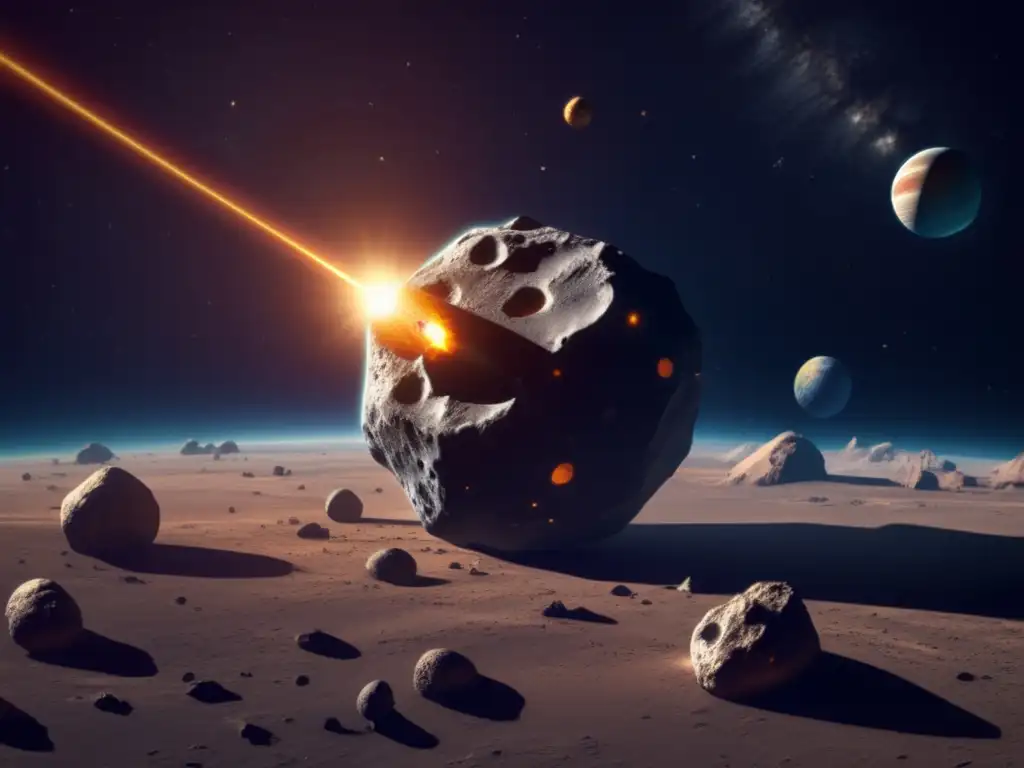Mission Asteroid: The Blueprint For Planetary Defense

Introduction
Since time immemorial, asteroids have been significant to human civilization for their immense potential in unlocking secrets of the universe. However, the same celestial bodies that dazzle and awe us can also pose a great threat to life as we know it on Earth. Therefore, it is imperative to develop measures to protect our planet from asteroids that may stray too close. This article discusses the 'Mission Asteroid' plan, which aims to provide a framework for planetary defense against asteroid impacts.
The Basics of Planetary Defense

What is Planetary Defense?
Planetary defense is a term used to describe the measures taken to protect the Earth from potentially hazardous objects (PHOs), such as asteroids, comets, and meteoroids. In other words, it is the study and implementation of procedures, technologies, and strategies aimed at mitigating the impact of PHOs with Earth.
Why is Planetary Defense Important?
The importance of planetary defense cannot be overstated since the impact of a large asteroid with Earth could result in catastrophic consequences, including mass extinction events. Historical records indicate that over 65 million years ago, an asteroid impact is believed to have caused the extinction of the dinosaurs. Though smaller asteroid impacts have occurred several times since then, the effects were not as devastating due to the relatively small size of the asteroid. Developing the capability to detect and deflect larger near-Earth asteroids is, therefore, essential for safeguarding humanity's future.
How Does Planetary Defense Work?
The primary aim of planetary defense is to prevent or mitigate the effects of a potential asteroid impact. Detecting PHOs and accurately predicting their trajectory are the first steps in achieving this aim. Once an asteroid is detected, it becomes possible to predict its orbit and estimate the likelihood of it colliding with Earth. If the asteroid is deemed hazardous, several approaches can be taken to mitigate its impact, such as deflecting its trajectory or destroying it.
Mission Asteroid: The Blueprint for Planetary Defense

What is Mission Asteroid?
Mission Asteroid is a white paper released by the Johns Hopkins University Applied Physics Laboratory that outlines a comprehensive plan for protecting the Earth from asteroid impacts. The report details the necessary technologies and strategies required to achieve this goal and provides a three-phase plan for implementing these measures.
What are the Three Phases of Mission Asteroid?
Phase One: Detection and Characterization
The first phase of Mission Asteroid involves detecting potentially hazardous asteroids and characterizing their size, trajectory, composition, and other essential properties. Achieving this requires investments in ground-based telescopes, space-based observatories, and radar systems capable of tracking asteroids effectively. Developing technologies to detect and track asteroids early on would provide vital early warning systems, giving scientists adequate time to prepare suitable mitigation strategies.
Phase Two: Deflection and Disruption
The second phase of Mission Asteroid aims to develop technologies that can deflect an asteroid's course or disrupt it altogether. There are several proposed methods for deflecting an asteroid, including using a kinetic impactor to hit the asteroid, deploying a gravity tractor to exert a gravitational force on the asteroid, or using lasers to vaporize parts of the asteroid, thus creating a thrust that changes its trajectory. The most viable method would depend on various factors, such as the size and composition of the asteroid.
Phase Three: Impact Preparedness
The final phase of Mission Asteroid involves preparing for an impact that is imminent and non-deflectable. This preparation involves developing strategies to minimize the impact's damage and loss of life, such as evacuating affected areas and providing emergency services. Additionally, this phase aims to develop strategies to mitigate the long-term effects of the impact, such as ensuring the continued supply of essential resources and rebuilding infrastructure.
Frequently Asked Questions

-
Q: How likely is the Earth to be impacted by a dangerous asteroid?
A: The likelihood of a dangerous asteroid hitting the Earth is relatively low, and no asteroid is currently known to pose a threat to Earth in the foreseeable future. However, it is still important to continue investing in planetary defense technologies and strategies to ensure that we are prepared when such an event does occur.
-
Q: How does NASA contribute to planetary defense?
A: NASA plays a crucial role in planetary defense by funding research programs that study asteroids and comet impacts and developing technologies to detect and deflect asteroids. Additionally, NASA works with international organizations to coordinate global responses to potential asteroid threats.
-
Q: Can an asteroid impact be completely prevented?
A: While it may be impossible to prevent all asteroid impacts, having a mature and robust planetary defense system in place can significantly reduce the impact's severity and save countless lives.
-
Q: What are some of the challenges associated with developing a planetary defense system?
A: Some of the main challenges include identifying all potentially hazardous objects, accurately predicting their orbits, developing mitigation technologies, and coordinating international efforts to respond to potential threats.
-
Q: How can individuals contribute to planetary defense?
A: Individuals can contribute to planetary defense by staying informed about potential hazards and supporting efforts to develop mitigation technologies and strategies. Additionally, individuals can promote awareness of the importance of planetary defense through social media and other channels.
Conclusion
Mission Asteroid provides a comprehensive blueprint for planetary defense against asteroid impacts. With adequate investment in technologies and strategies, it is possible to mitigate the impact of potentially hazardous objects and protect our planet from catastrophic events. While the likelihood of a dangerous asteroid impact may be low, being prepared is essential for safeguarding humanity's future, and Mission Asteroid provides an excellent starting point for achieving this goal.
Thank you for reading this article, and we encourage you to share your thoughts and opinions on planetary defense in the comments section below. Remember to subscribe to www.asteroidrealm.com for more exciting and informative content related to asteroids and space exploration.
Additional Resources

- NASA Center for Near Earth Object Studies (CNEOS)
- European Space Agency (ESA) - Space Debris and Situational Awareness
- B612 Foundation
 Stellar Shield: The Role Of Technology In Asteroid Defense
Stellar Shield: The Role Of Technology In Asteroid Defense Earth’s Sentinels: The Science Of Detecting And Diverting Asteroids
Earth’s Sentinels: The Science Of Detecting And Diverting Asteroids Our Cosmic Bodyguard: Technologies In Asteroid Defense
Our Cosmic Bodyguard: Technologies In Asteroid DefenseIf you want to discover more articles similar to Mission Asteroid: The Blueprint For Planetary Defense, you can visit the Planetary Defense category.
Leave a Reply

Articulos relacionados: